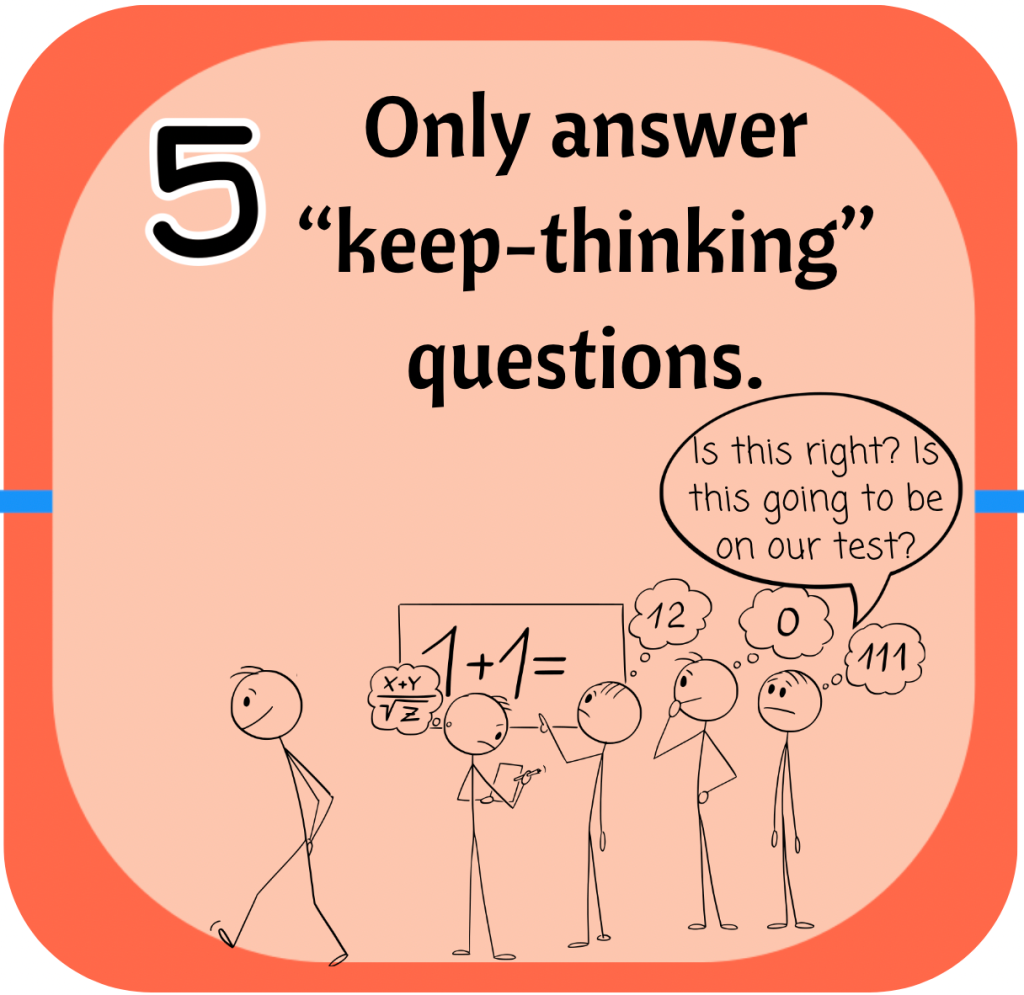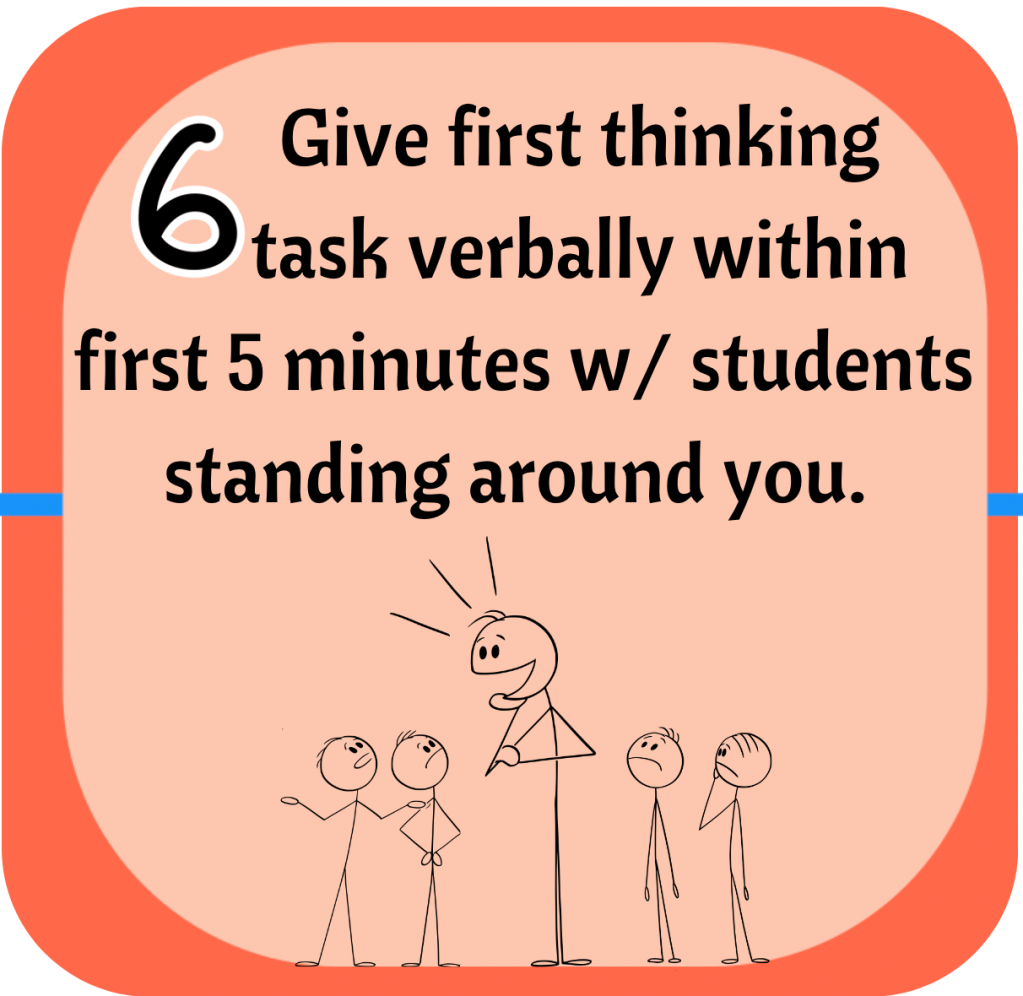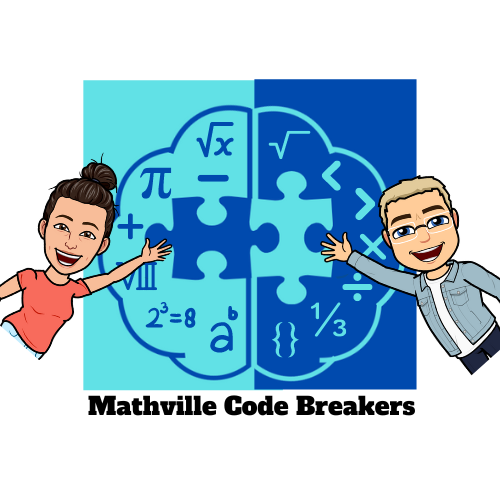Okay folks, following on from last week, here’s our second update of the BTC in Eureka post. We originally wrote this on our Mathville Codebreaker Facebook page, but we’re posting it here (WordPress rocks!) along with our graphics for practices 4, 5, & 6.
– Find part 1 here: https://bit.ly/BTCBlogPart1
– Find part 3 here: https://bit.ly/BTCBlogPart3
– Find part 4 here: https://bit.ly/BTCBlogPart4
– Find our free & paid EngageNY & BTC resources here: https://bit.ly/CodeBreakersFollowLink
Some points to note:
– After each approach is outlined, we will highlight why that practice is important and beneficial to Eureka teachers.
– Those who have implemented the approach, please comment with your thoughts, ideas, and resources.
– When you see (Liljedahl, 2019), you know that I’m referencing information directly from the text.
– The post will take approximately 10 minutes to read. Grab a coffee and enjoy!
– We recommend watching this video to get a snapshot of a Thinking Classroom in real life:
On that note, let’s dive into the fourth practice to develop a thinking classroom within the Eureka framework.

![]() 𝐏𝐫𝐚𝐜𝐭𝐢𝐜𝐞 #4: 𝐃𝐞𝐟𝐫𝐨𝐧𝐭 𝐓𝐡𝐞 𝐂𝐥𝐚𝐬𝐬𝐫𝐨𝐨𝐦:
𝐏𝐫𝐚𝐜𝐭𝐢𝐜𝐞 #4: 𝐃𝐞𝐟𝐫𝐨𝐧𝐭 𝐓𝐡𝐞 𝐂𝐥𝐚𝐬𝐬𝐫𝐨𝐨𝐦:
In order to engage students in deep thinking, we should arrange our classrooms in a way that deviates from the traditional setup. This means that we should try to not have a “front” from where we teach in our classroom. “Every time we worked in classrooms that were super organized we have more difficulty generating thinking. Classrooms need to have just-right amount of disorder for thinking to flourish.” (Liljedahl, 2021). Our classroom furniture should be set up in a way where groups of students are looking at each other. Ideally, your furniture isn’t too close to the vertical non-permanent boards that students are working on. For further tips on de-fronting the classroom, check out this wonderful post on de-fronting classrooms!
![]() 𝐖𝐡𝐲 𝐢𝐬 𝐭𝐡𝐢𝐬 𝐢𝐦𝐩𝐨𝐫𝐭𝐚𝐧𝐭 𝐟𝐨𝐫 𝐄𝐮𝐫𝐞𝐤𝐚 𝐭𝐞𝐚𝐜𝐡𝐞𝐫𝐬? As we discussed in blog post #1, the ultimate goal of the BTC approach is getting students to think through problems. The Eureka program doesn’t always promote this concept. Altering the layout of classroom furniture & de-fronting the classroom will promote a mindset shift among your students. The flexibility of movement in the classroom will promote the idea that yours is a thinking classroom and those that work within it are active constructors of knowledge, not passive receivers of it.
𝐖𝐡𝐲 𝐢𝐬 𝐭𝐡𝐢𝐬 𝐢𝐦𝐩𝐨𝐫𝐭𝐚𝐧𝐭 𝐟𝐨𝐫 𝐄𝐮𝐫𝐞𝐤𝐚 𝐭𝐞𝐚𝐜𝐡𝐞𝐫𝐬? As we discussed in blog post #1, the ultimate goal of the BTC approach is getting students to think through problems. The Eureka program doesn’t always promote this concept. Altering the layout of classroom furniture & de-fronting the classroom will promote a mindset shift among your students. The flexibility of movement in the classroom will promote the idea that yours is a thinking classroom and those that work within it are active constructors of knowledge, not passive receivers of it.

![]() 𝐏𝐫𝐚𝐜𝐭𝐢𝐜𝐞 #𝟓: 𝐇𝐨𝐰 𝐖𝐞 𝐀𝐧𝐬𝐰𝐞𝐫 𝐐𝐮𝐞𝐬𝐭𝐢𝐨𝐧𝐬 𝐈𝐧 𝐀 𝐓𝐡𝐢𝐧𝐤𝐢𝐧𝐠 𝐂𝐥𝐚𝐬𝐬𝐫𝐨𝐨𝐦:
𝐏𝐫𝐚𝐜𝐭𝐢𝐜𝐞 #𝟓: 𝐇𝐨𝐰 𝐖𝐞 𝐀𝐧𝐬𝐰𝐞𝐫 𝐐𝐮𝐞𝐬𝐭𝐢𝐨𝐧𝐬 𝐈𝐧 𝐀 𝐓𝐡𝐢𝐧𝐤𝐢𝐧𝐠 𝐂𝐥𝐚𝐬𝐬𝐫𝐨𝐨𝐦:
A typical teacher will answer between 200-600 questions every day! While it may seem that answering student questions always helps our students learn, Liljedahl found that this is not always the case. Liljedahl identified 3 different types of questions that teachers get asked. They are…
𝟏) 𝐏𝐫𝐨𝐱𝐢𝐦𝐢𝐭𝐲 𝐐𝐮𝐞𝐬𝐭𝐢𝐨𝐧𝐬: These are questions that students will only ask their teacher when the teacher is close by. They do this to conform to the role of a student, even if thet know or can find the answer themselves. (Example: “What class do we have after recess?” “How many questions do we need to answer?”
𝟐) 𝐒𝐭𝐨𝐩-𝐓𝐡𝐢𝐧𝐤𝐢𝐧𝐠 𝐐𝐮𝐞𝐬𝐭𝐢𝐨𝐧𝐬: Thinking can be energy-consuming for students. For them, they’d rather not have to think. Therefore, they will often ask their teacher stop-thinking questions. (Example: “Do we have to learn this?” “Is this answer correct?”
It turns out that 90% of the 200-600 questions that teachers are asked are either proximity questions. It’s important that we encourage as much thinking as possible from our students and therefore, it’s important that we avoid answering these questions. So, what about the other 10% of questions that we get asked? They are known as…
𝟑) 𝐊𝐞𝐞𝐩-𝐓𝐡𝐢𝐧𝐤𝐢𝐧𝐠 𝐐𝐮𝐞𝐬𝐭𝐢𝐨𝐧𝐬: These are asked by students so that they can further engage with the task at-hand. They are usually about clarification or extensions. (Example: “Can we get the next set of questions?” “Can we solve this problem using a tape diagram as well as the standard algorithm?” These questions drive further thinking and should be encouraged in our classrooms.
I informed my students about these 3 types of questions. They know that they have to think to learn and they very quickly stopped asking proximity & stop-thinking questions. Students will even correct their classmates when they hear proximity questions being asked. Liljedahl recommends achnowledging to students that you heard their question and redirecting it with another question or statement. “What do you think?” “What makes you ask that?” “I think it would be better if you explained your answer to me rather than me telling you the correct one.” Liljedahl even recommends simply walking away when anything other than keep-thinking-questions are asked (check out our above graphic)! Harsh?? Perhaps. However, this will help develop that mindset shift that you’re looking for in your classroom.
![]() 𝐖𝐡𝐲 𝐢𝐬 𝐭𝐡𝐢𝐬 𝐢𝐦𝐩𝐨𝐫𝐭𝐚𝐧𝐭 𝐟𝐨𝐫 𝐄𝐮𝐫𝐞𝐤𝐚 𝐭𝐞𝐚𝐜𝐡𝐞𝐫𝐬? The setup of Eureka lessons where teachers model how to complete the Problem Sets tells students that the teacher is the holder of information. When they need more information, they should get it from the teacher. By only asking keep-thinking questions, students are encouraged to solve problems for themselves, either using resources in the classroom or their peers. This puts students at the center of the learning & further pushes the teacher into a facilitator role.
𝐖𝐡𝐲 𝐢𝐬 𝐭𝐡𝐢𝐬 𝐢𝐦𝐩𝐨𝐫𝐭𝐚𝐧𝐭 𝐟𝐨𝐫 𝐄𝐮𝐫𝐞𝐤𝐚 𝐭𝐞𝐚𝐜𝐡𝐞𝐫𝐬? The setup of Eureka lessons where teachers model how to complete the Problem Sets tells students that the teacher is the holder of information. When they need more information, they should get it from the teacher. By only asking keep-thinking questions, students are encouraged to solve problems for themselves, either using resources in the classroom or their peers. This puts students at the center of the learning & further pushes the teacher into a facilitator role.

![]() 𝐏𝐫𝐚𝐜𝐭𝐢𝐜𝐞 #𝟔: 𝐖𝐡𝐞𝐧, 𝐖𝐡𝐞𝐫𝐞, 𝐀𝐧𝐝 𝐇𝐨𝐰 𝐓𝐨 𝐆𝐢𝐯𝐞 𝐓𝐡𝐢𝐧𝐤𝐢𝐧𝐠 𝐓𝐚𝐬𝐤𝐬
𝐏𝐫𝐚𝐜𝐭𝐢𝐜𝐞 #𝟔: 𝐖𝐡𝐞𝐧, 𝐖𝐡𝐞𝐫𝐞, 𝐀𝐧𝐝 𝐇𝐨𝐰 𝐓𝐨 𝐆𝐢𝐯𝐞 𝐓𝐡𝐢𝐧𝐤𝐢𝐧𝐠 𝐓𝐚𝐬𝐤𝐬
When To Give Thinking Tasks– Assign your thinking tasks within 5 minutes of the lesson’s beginning. If you have to introduce a new concept, you have 5 minutes to do so before student attention quickly drops off. “The further into the lesson the teacher waited before giving the task, the less effective it became.” (Liljedahl, 2021). Keeping to this 5 minute rule will get the positive learning energy flowing in your class.
Where To Give Thinking Tasks– Liljedahl recommends having students standing up while you give the task. Personally, I give the tasks to my 4th grade students while they sit on the carpet. Having them stand may work better with middle & high school students. So long as I give the task within 5 minutes, I don’t think that having the students sit detracts from their ability to complete the task. Remember, if students are completing a curricular task, I give them the final problem set question.
How To Give Thinking Tasks– Liljedahl recommends first giving the task orally. While you do this, write down the main points on the board. It’s important to only write this “textual residue” and not to write the whole question. This reduces cognitive load and helps students improve their ability to decipher what is being asked in word problems. For example, here is a question from Grade 4, Module 2, Lesson 2:
“Javier’s dog weighs 3,902 grams more than Bradley’s dog. Bradley’s dog weighs 24 kilograms 175 grams. How much does Javier’s dog weigh?”
However, when we write on the board, the textual residue should look something like this:
“Javier dog: 3902g > Bradley’s dog.
Bradley’s dog: 24kg 175g.
Javier’s dog?”
![]() 𝐖𝐡𝐲 𝐢𝐬 𝐭𝐡𝐢𝐬 𝐢𝐦𝐩𝐨𝐫𝐭𝐚𝐧𝐭 𝐟𝐨𝐫 𝐄𝐮𝐫𝐞𝐤𝐚 𝐭𝐞𝐚𝐜𝐡𝐞𝐫𝐬? The Eureka mini-lessons can be unengaging. Students do not want to listen to a lecture on how to solve questions. They enjoy the challenge of tackling the problems themselves. By giving them the task within 5 minutes of the lesson, they are kept engaged and a state of flow is maintained.
𝐖𝐡𝐲 𝐢𝐬 𝐭𝐡𝐢𝐬 𝐢𝐦𝐩𝐨𝐫𝐭𝐚𝐧𝐭 𝐟𝐨𝐫 𝐄𝐮𝐫𝐞𝐤𝐚 𝐭𝐞𝐚𝐜𝐡𝐞𝐫𝐬? The Eureka mini-lessons can be unengaging. Students do not want to listen to a lecture on how to solve questions. They enjoy the challenge of tackling the problems themselves. By giving them the task within 5 minutes of the lesson, they are kept engaged and a state of flow is maintained.
Because the Eureka Problem Set questions are heavily word-based, it’s important that students learn to figure out what they’re being asked. Giving the tasks orally & only leaving “textual residue” on the board develops this skill. By implementing this practice, you’ll find that your students are able to decode what word problems are asking them with much more ease. In addition, Liljedahl says the following: “giving tasks verbally produced ore thinking-sooner & deeper- and generated fewer questions at every grade level.” (Lilhedahl, 2021)
![]() That wraps up our post on practices 4, 5, and 6 from “Building Thinking Classrooms in Mathematics” by Peter Liljedahl. As you may have noticed, while the first 3 practices are about introducing BTC to your class, these 3 primarily deal with how we the teachers are behaving. Implementing practices 4, 5 & 6 will push you more into that facilitator role and will put the students at the center of the learning.
That wraps up our post on practices 4, 5, and 6 from “Building Thinking Classrooms in Mathematics” by Peter Liljedahl. As you may have noticed, while the first 3 practices are about introducing BTC to your class, these 3 primarily deal with how we the teachers are behaving. Implementing practices 4, 5 & 6 will push you more into that facilitator role and will put the students at the center of the learning.
We will finish with this question. Please leave responses in the comment section.
“What are some aspects in this post that immediately feel correct?”
Please post any responses/thoughts/comments/ideas/questions below!
Thank you for reading! ![]()
Check out our free & paid EnageNY + BTC resources here! https://bit.ly/CodeBreakersFollowLink

